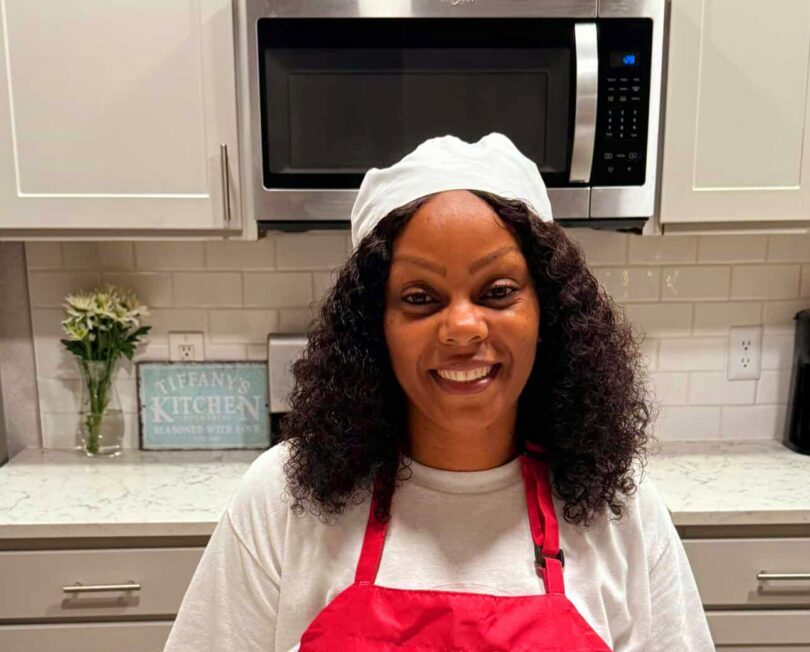Alright – so today we’ve got the honor of introducing you to Stephanie Sarazin. We think you’ll enjoy our conversation, we’ve shared it below.
Hi Stephanie, really happy you were able to join us today and we’re looking forward to sharing your story and insights with our readers. Can you tell us a little bit about yourself, what do you do?
“What do you do?” is a question that trips me up. It’s such a common question we ask one another; you’d think I’d have a canned answer, but I don’t! Not a succinct one, anyway, one that doesn’t need an explanation, like “pastry chef” or “pediatrician.” In a word, I could say I’m a “writer,” but writing is really just the tool I use to amplify the topics of grief, loss, and healing. I wrote a book about grieving the living, or more specifically, what is ambiguous grief with some stories and tools for those navigating it’s gnarled nuances!
While researching for my book back in 2022, I became interested in some griefy-adjacent topics, namely the influence of hope on the grieving and understanding the impact of rituals for the grieving. Inspired by what I learned from my research, I began working with clients and recently started guiding small group, nature-based “grief expeditions,” which, of course, I’ll eventually write about! Saying it this way, I’m reminded of the children’s book, “If You Give A Mouse A Cookie,” where one action begins a chain reaction of further actions, each triggering the next, in a never-ending cycle. Writer>Researcher>Grief Guide>Writer. But, that’s not something I ever saw happening, at least not at this age and stage!

So, getting to the heart of it all: purpose. If writing about grief, loss, and healing is your purpose, how did you find it?
Well, I like to say that my purpose found me – at least my professional purpose, anyway! As a kid, I aspired to be a writer but strayed from that path in search of more practical (employable) pursuits. I graduated from college, interned at The White House, and earned a Master of Public Policy degree. By my early 30s, I was living the dream, happily married with three great kids and a job I loved in the nonprofit sector. Fast forward to 42, and I discovered my marriage wasn’t what I believed it to be. After the shock wore off and the divorce was finalized, I began to focus on my grief and sought to learn how to tend to it. However, I found a glaring lack of resources and started writing and publishing essays about “How to grieve the living.” I received an overwhelming response from others who had similar experiences.
Curious about what * exactly * made this grief feel so different, I started interviewing people and deployed a survey. The data revealed that, in addition to divorce, many common life events activate ambiguous grief, including addiction, a diagnosis, dementia, estrangement, incarceration, job loss, empty nesting, and others. I also found that with important non-death losses, the experience of hope often presents and that without societal norms to engage (like funerals), these losses often go unrecognized by others, causing grievers to feel unseen and invalidated. Worse, if shame or embarrassment are internalized by the griever, they tend to isolate and grieve alone. Which is just really heartbreaking, and I get it.
That was the motivation behind writing my book –to help just one person feel less alone in their ambiguous grief. While its informed, in part, by my own experience and research, it shares the personal stories of several others, too. The book, Soulbroken: A Guidebook for Your Journey Through Ambiguous Grief (Hachette, 2022), is a Nautilus Books Gold Winner and is now in its second printing. This makes me so happy because it means people who need it are finding it! And while writing about grief and loss isn’t what I expected to be doing, I’m truly grateful. To be of comfort, and to make a meaningful difference to this community is not only an honor, but it also brings me a deep sense of purpose, too.

If you had to pick three qualities that are most important to develop, which three would you say matter most?
What a great question. For me, what comes to mind are three practices that have helped me make my most exponential shifts. I find they are especially helpful when going through a transition or seeking clarity on something – and as my friends will tell you, I recommend them often!
1) Honor your curiosity: Get curious about yourself and your interests. What are you pondering? What creates wonder? Asking those questions and paying attention to what comes next can be an informative exercise. For me, “How do we grieve the living?” and “Why does my grief feel different?” were two questions I needed answered. By following my curiosity about the next answer and the next, I not only found the answer but more questions, too! Ultimately, this “give a mouse a cookie” loop has helped me unlock dormant desires, excavate buried gifts, and nudge me toward a path of passion and purpose I previously hadn’t known.
2) Discipline disappointments: Regardless of what it is you want, whether a relationship, a job promotion, or something else – it’s normal to feel disappointed when you don’t have it or, even worse, feel like you never will. For me, I’ve found that by disciplining my disappointments (allowing the feeling but not wallowing), I gain clarity on the situation and can “sort” what is and isn’t within my control. Focusing on what I can control allows me to direct my energy in an affirming way while identifying what isn’t (for example, how someone behaves) becomes data. Like any data, it can be helpful in spotting patterns and predicting future behavior – helping further hone how to sort, file, and discipline disappointments.
3) Cultivate contrast: If you’re feeling stuck or not sure what’s next, you aren’t alone! This can be frustrating, especially if you’re a natural problem solver. But if the answer is elusive, taking a different approach may help. What I’ve learned is that by letting go of what *isn’t* for me, I create space for what *is*. So, the next time you aren’t sure what it is you want (whether in your personal or professional life), try starting with what you know you *don’t* want, and keep going. It’s kind of a process of elimination, but as you get more skilled in cultivating contrast, over time, you’ll discern the difference and (hopefully) identify the solution sooner!

Okay, so before we go, we always love to ask if you are looking for folks to partner or collaborate with?
Yes! In working to normalize grief as a natural response to loss, I believe that collaboration is key. Regardless of who or what we’re grieving or for how long, my hope is that the more we speak, write, and share about our important losses, the better we’ll be able to show up for ourselves and each another. If this resonates, or if I can be of service, let’s connect! You can e-mail me [email protected] or follow me on Instagram @Stephing_thru. And thanks for reaching out. I really appreciate the opportunity to talk grief and loss with you today – as you know, it’s a bold journey we’re all going to take, if we haven’t already.
Contact Info:
- Website: https://www.stephaniesarazin.com
- Instagram: https://www.instagram.com/stephing_thru/
- Linkedin: https://www.linkedin.com/in/stephaniesarazin/
- Other: Check out my griefy book recs and other goodies for growth at my Bookshop Shop! https://bookshop.org/shop/RiseUpRooted




so if you or someone you know deserves recognition please let us know here.




